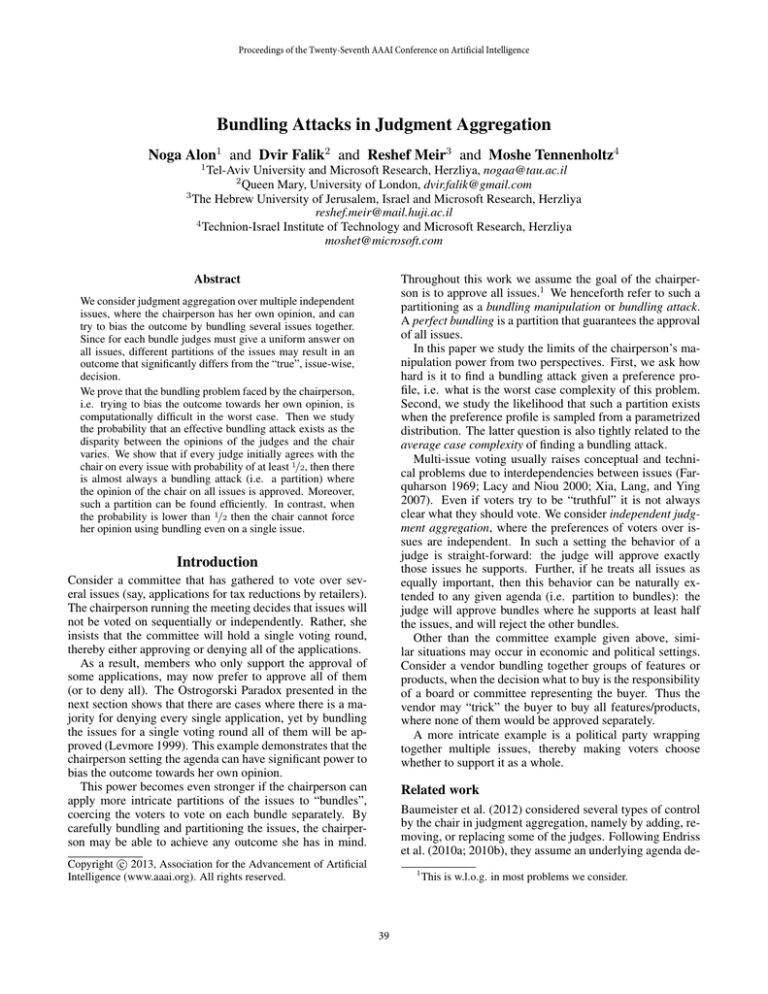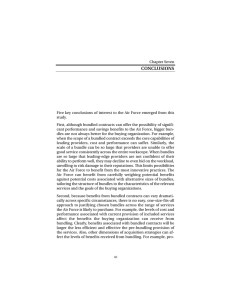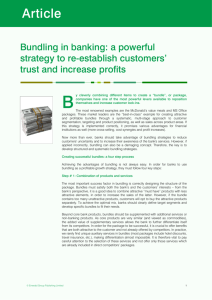
Proceedings of the Twenty-Seventh AAAI Conference on Artificial Intelligence
Bundling Attacks in Judgment Aggregation
Noga Alon1 and Dvir Falik2 and Reshef Meir3 and Moshe Tennenholtz4
1
Tel-Aviv University and Microsoft Research, Herzliya, nogaa@tau.ac.il
2
Queen Mary, University of London, dvir.falik@gmail.com
3
The Hebrew University of Jerusalem, Israel and Microsoft Research, Herzliya
reshef.meir@mail.huji.ac.il
4
Technion-Israel Institute of Technology and Microsoft Research, Herzliya
moshet@microsoft.com
Throughout this work we assume the goal of the chairperson is to approve all issues.1 We henceforth refer to such a
partitioning as a bundling manipulation or bundling attack.
A perfect bundling is a partition that guarantees the approval
of all issues.
In this paper we study the limits of the chairperson’s manipulation power from two perspectives. First, we ask how
hard is it to find a bundling attack given a preference profile, i.e. what is the worst case complexity of this problem.
Second, we study the likelihood that such a partition exists
when the preference profile is sampled from a parametrized
distribution. The latter question is also tightly related to the
average case complexity of finding a bundling attack.
Multi-issue voting usually raises conceptual and technical problems due to interdependencies between issues (Farquharson 1969; Lacy and Niou 2000; Xia, Lang, and Ying
2007). Even if voters try to be “truthful” it is not always
clear what they should vote. We consider independent judgment aggregation, where the preferences of voters over issues are independent. In such a setting the behavior of a
judge is straight-forward: the judge will approve exactly
those issues he supports. Further, if he treats all issues as
equally important, then this behavior can be naturally extended to any given agenda (i.e. partition to bundles): the
judge will approve bundles where he supports at least half
the issues, and will reject the other bundles.
Other than the committee example given above, similar situations may occur in economic and political settings.
Consider a vendor bundling together groups of features or
products, when the decision what to buy is the responsibility
of a board or committee representing the buyer. Thus the
vendor may “trick” the buyer to buy all features/products,
where none of them would be approved separately.
A more intricate example is a political party wrapping
together multiple issues, thereby making voters choose
whether to support it as a whole.
Abstract
We consider judgment aggregation over multiple independent
issues, where the chairperson has her own opinion, and can
try to bias the outcome by bundling several issues together.
Since for each bundle judges must give a uniform answer on
all issues, different partitions of the issues may result in an
outcome that significantly differs from the “true”, issue-wise,
decision.
We prove that the bundling problem faced by the chairperson,
i.e. trying to bias the outcome towards her own opinion, is
computationally difficult in the worst case. Then we study
the probability that an effective bundling attack exists as the
disparity between the opinions of the judges and the chair
varies. We show that if every judge initially agrees with the
chair on every issue with probability of at least 1/2, then there
is almost always a bundling attack (i.e. a partition) where
the opinion of the chair on all issues is approved. Moreover,
such a partition can be found efficiently. In contrast, when
the probability is lower than 1/2 then the chair cannot force
her opinion using bundling even on a single issue.
Introduction
Consider a committee that has gathered to vote over several issues (say, applications for tax reductions by retailers).
The chairperson running the meeting decides that issues will
not be voted on sequentially or independently. Rather, she
insists that the committee will hold a single voting round,
thereby either approving or denying all of the applications.
As a result, members who only support the approval of
some applications, may now prefer to approve all of them
(or to deny all). The Ostrogorski Paradox presented in the
next section shows that there are cases where there is a majority for denying every single application, yet by bundling
the issues for a single voting round all of them will be approved (Levmore 1999). This example demonstrates that the
chairperson setting the agenda can have significant power to
bias the outcome towards her own opinion.
This power becomes even stronger if the chairperson can
apply more intricate partitions of the issues to “bundles”,
coercing the voters to vote on each bundle separately. By
carefully bundling and partitioning the issues, the chairperson may be able to achieve any outcome she has in mind.
Related work
Baumeister et al. (2012) considered several types of control
by the chair in judgment aggregation, namely by adding, removing, or replacing some of the judges. Following Endriss
et al. (2010a; 2010b), they assume an underlying agenda de-
c 2013, Association for the Advancement of Artificial
Copyright Intelligence (www.aaai.org). All rights reserved.
1
39
This is w.l.o.g. in most problems we consider.
Preliminaries
fined by a set of logical formulae. That is, the opinion of
each agent over an issue may depend on his opinions over
other issues on the agenda. Baumeister et al. study the computational complexity of these problems under a particular
aggregation rule.
Conitzer, Lang and Xia (2009) studied several variations
of agenda manipulation problems in voting with multiple binary issues. They considered issues that are interdependent,
and thus setting the order by which issues are voted on can
significantly change the outcome.
Partitioning was studied in voting scenarios, where the
chair has the power to partition either the voters or the
candidates into two distinct sets, thereby affecting the outcome (Bartholdi, Tovey, and Trick 1992; Hemaspaandra,
Hemaspaandra, and Rothe 2007).
In all three settings described above, much of the conceptual and computational complexity stems from the intricate
dependency between the issues. In our setting issues are independent, which corresponds to premise-only agendas preference aggregation (Endriss, Grandi, and Porello 2010b),
or to separable preferences in multi-issue voting (Conitzer,
Lang, and Xia 2009). Thus in the setting we focus on some
of the previously studied problems become trivial (for example the order of issues is irrelevant), and the difficulty arises
due to the rich set of possible partitions.
Bundling of products has been studied in the context of
auctions (Palfrey 1983). In such settings the bidders can
make individual decisions, and the usefulness of bundling
to the auctioneer is derived from her uncertainty regarding
bidders’ valuations.
We use bold characters to denote column vectors, as in
a = (a1 , a2 , . . .), upper case letters A, B, C, . . . to denote
sets, and X, Y, Z to denote random variables. Row vectors
are denoted with an overbar, e.g. a. Matrices are denoted
with calligraphic letters A, B, etc. For binary vectors, we
denote by |a| the number of ’1’ entries in a (i.e. the Hamming weight of a). We denote the set {1, . . . , m} by [m].
We denote 1 = (1, 1, . . . , 1) and 0 = (0, 0, . . . , 0). For
a binary vector a, let maj(a) ∈ {0, 1} be the majority of
entries. As a convention, we break ties toward 1 (other tiebreaking methods require slight modifications).
An instance of Independent judgment aggregation (IJA)
is composed of n judges J (also called voters), m issues I,
m
and a n × m binary matrix A = (aji )nj=1 i=1 , where aji = 1
when judge j is in favor of approving issue i, and aji = 0
otherwise. Denote the i’th column (issue) of A by ai , and
the j’th row (judge) by aj .
The outcome of aggregating the opinions on each
issue separately, is denoted by s = maj(A) =
(maj(a1 ), . . . , maj(am )). Intuitively, the outcome of a
bundling attack (a partition) on IJA A is as if every judge
answers the same on all issues in each bundle, according to
the majority of issues in the bundle. Thus the final outcome
can be very different from maj(A).
Formally, let the submatrix A|C contain columns i ∈ C
of the matrix A (i.e. A restricted to the bundle C ⊆
I). The decision on bundle C is simply dC (A) =
maj(maj(a1 |C ), . . . , maj(an |C )). That is, each voter selects 1 or 0 according to the number of issues in C on which
he has an affirmative opinion, and then the majority of voters decides on a uniform decision for all issues. We denote
by s(C, A) ∈ {0|C| , 1|C| } the row vector where every entry
equals to dC (A).
Our contribution
We show that finding whether a bundling attack exists is NPhard under two different variations of the problem. First, it is
hard to find whether a single bundle can be used to approve a
large fraction of the issues. Second, it is hard to find a perfect
bundling, i.e. a partition that results in approving all issues.2
Interestingly, the first problem turns out to be related to the
O PTIMAL L OBBYING problem (Christian et al. 2007), albeit
in a non-intuitive way.
We then focus on the frequency of successful bundling
attacks, when each voter approves every issue (i.e. agrees
with the chair) with independent probability p. Our main result shows that for p = 1/2 (and clearly for any larger value),
a perfect bundling attack almost always exists. In contrast,
when p < 1/2 the probability that even a single issue can
be approved using bundling goes to zero (when the number
of voters is not extremely small). As a corollary, finding
whether a perfect bundling attack exists is easy on average
(for any value of p). Some proofs are omitted or replaced
with a proof sketch due to lack of space, and appear in the
full version of this paper.3
Bundling attacks
A Bundling attack on IJA instance A is a partition P of the
m issues. Let P = (C1 , . . . , Ct∗ ). The outcome of the
attack is accepted by concatenating the outcomes of all bundles. Formally,
s = s(P, A) = (s(C1 , A), s(C2 , A), . . . , s(Ct∗ , A)).
We allow to specify partial partitions, where the unspecified
columns are assumed to be singletons.
Suppose that the goal of the chair is to approve all issues.
Then the success of a bundling attack (i.e. a partition P to
bundles) is determined by the number of positive issues in
the outcome, i.e. by |s(P, A)|. In particular, we say that P
is a perfect bundling attack if s(P, A) = 1, i.e. if the chair
can approve all issues.
Remark 1. As long as there are no assumptions on the distribution, w.l.o.g. the goal vector is 1.
This is since we can replace 1 with any other target vector
t, and replace A with a modified matrix where the names 0
and 1 are flipped in the appropriate columns, formally A =
A+1×(1−t)( mod 2). Then |{i : s(P, A)i = ti }| equals
to |s(P, A )|.
2
Note that checking whether a perfect outcome can be attained
with single bundle is trivial - just bundle all issues and check if all
issues are approved.
3
Available from http://tinyurl.com/dx9cuh6.
40
As for the power of bundling attacks, there are simple examples where maj(A) = 0, but maj(P, A) = 1 (for a single bundle P = {I}). If the fraction of 1’s in A is less than
1/4, then it is not hard to see that a perfect bundling attack
is impossible.
shown that OL’, which is similar in spirit to these variations,
is also NP-hard.
We are now ready to prove the hardness of our own problem. The reduction from OL’ demonstrates the reversed
roles of the elements: the voters of the OL’ problem become
issues in k-B UNDLING and vice versa.
J \ I i1 i2 i3
The Ostrogorski paradox.
1
0
0 0
The following IJA instance
2
0
0 0
appears in (Levmore 1999):
3
1
1 0
If we aggregate the opinions
4
1
0 1
of the five judges on each issue
5
0
1 1
separately, we get 0 is all issues,
s
0
0 0
i.e. s = maj(A) = (0, 0, 0).
However, if we bundle all issues together then the three
last voters will vote 1, and hence the biased outcome will
become s = s(I, A) = (1, 1, 1). This example shows
that there are cases where the chair can exploit disagreement among judges to achieve a perfect bundling attack even
when it completely reverses the original outcome.
Proposition 1. k-B UNDLING is NP-complete.
Proof sketch. Given an OL’ instance (A, r), we define an
instance of k-B UNDLING where the IJA matrix is B = AT
(i.e. the transpose of A), and k = n∗ − r. Note that in the
k-B UNDLING instance we have n = m∗ voters and m = n∗
issues. Let K ⊆ [m] of size k, and R = [m] \ K. It can be
verified that K is a successful bundling attack on B iff R is
a successful lobbying attack on A.
Note that if k is a constant, then k-B
UNDLING can be
solved in polynomial time: just try all m
k possible bundles,
and check if the attack succeeds.
We emphasize that the hardness of A NY B UNDLING does
not follow directly from k-B UNDLING, since in our proof
we have to allow values of k above m/2. However, A NYB UNDLING has been independently shown to be N P -hard
in (Alon et al. 2013).
Hardness of Bundling
We define the following variations of the bundling problem.
The first is achieving as many positive issues as possible
with a single bundle. The second problem is to guarantee
that all issues will reach a positive decision, allowing as
many bundles as needed.
Perfect bundling by partitioning is hard
Consider the problem I S T RIPARTITE described next. We are
not aware of any previous complexity analysis of the I S T RI PARTITE problem, however it can be easily shown to be NPhard by a reduction from graph 3-coloring (Karp 1972).
A NY B UNDLING
INPUT A N IJA INSTANCE A.
QUESTION I S THERE A BUNDLE C ⊆ I , S . T. s(C, A) = 1?
k-B UNDLING
INPUT A N IJA INSTANCE A, A NUMBER k ≤ m.
QUESTION I S THERE A BUNDLE C ⊆ I OF SIZE k, S . T.
s(C, A) = 1?
P ERFECT B UNDLING
INPUT A N IJA INSTANCE A.
QUESTION I S THERE A PARTITION P , S . T.
I S T RIPARTITE
INPUT A 3- UNIFORM HYPERGRAPH (V, E).
QUESTION A RE THERE V1 , V2 , V3 S . T. V1 V2 V3 =
V ( I . E . FORM A PARTITION OF V ), AND EVERY e ∈ E
INTERSECTS ALL THREE SETS ?
s(P, A) = 1?
Proposition 2. P ERFECT B UNDLING is NP-complete.
All three problems are clearly in NP.
Proof sketch. We prove by a reduction from I S T RIPARTITE.
Let t = |V | − 3. We define a column (an issue) for each
vertex v ∈ V . For every hyperedge e = (v, v , v ), we
define 5 voters as follows. Two voters (denoted by the set
Ae ) approve all three issues, and each of the 3 issues is also
approved by another single voter (forming the set Be ).
Next, we add t template columns, that are approved by all
voters. Finally, we add |E|−1 dummy voters, with rows that
are all zero. Thus we have an IJA instance with n = 6|E|−1
and m = t + |V | = 2|V | − 3.
“⇒” Assume first that (V, E) is tripartite. Then we can
use the following partition to three bundles. We bundle every
set Vi , i ∈ {1, 2, 3} with |Vi | − 1 template columns. In each
such bundle, for every edge e, both voters in Ae and exactly
one voter from Be have more ones than zeros. Thus the
bundle is approved.
“⇐” Assume that there is a successful bundling attack
P = (C1 , . . . , Ck ). Then in every bundle Ci ∈ P there is
a majority of approved rows, i.e. at least 3|E| non-dummy
voters.
Bundling with a single bundle is hard
We claim that the first two problems are NP-hard. To that
end, we want to use a reduction from O PTIMAL L OBBYING
(OL) (Christian et al. 2007). However, we need to slightly
modify the original OL problem.
∗
We define the function majr : {0, 1}l → {0, 1} as fol∗
lows. majr (a) returns 1 if |a| ≥ (l + r)/2 ones, and otherwise returns 0 (i.e. maj0 ≡ maj). We extend majr to
operate on matrices by operating on each column independently, as we did with maj.
O PTIMAL L OBBYING ’ (OL’)
INPUT A N IJA INSTANCE A WITH n∗ VOTERS ,
SUES , A NATURAL NUMBER r ≤ n∗ /2.
∗
m∗ IS -
∗
QUESTION I S THERE A ∈ {0, 1}n ×m S . T. A, A DIFFER
IN AT MOST r ROWS , AND |majr (A )| ≥ m∗ /2 ?
Note that w.l.o.g. modified rows in matrix A are 1. Recently, Nehama (2013) proved that a wide parametrized family of problems that include OL, are all NP-hard. It can be
41
Thus w.p. tp (which goes to 1 with m tending to infinity) a single voter has a majority of ones, and will therefore
approve the full bundle.
For any fixed value of m, tp is some fixed value strictly
greater than 1/2. Thus we can do the same calculation again
(replacing p for tp and m for n) to show that a majority of
voters will vote ’1’ almost always.
By a careful examination of the partition of template
columns, it can be shown that there are exactly 3 bundles.
Then, we show that exactly |E| voters of type B approve
each bundle, which means that all of the 2|E| type A voters must approve all bundles. A voter in Ae = (v, v , v )
will approve all three bundles only if each of his approved
columns belongs to a different bundle. Thus every bundle
must intersect every triplet e. In other words, the partition P
(of non-template columns) is a 3-partition of (V, E).
Low Agreement (p < 1/2)
When there are very few voters and many issues (say, n =
o(ln m)), then even if p < 1/2 there will be some column
(w.h.p.) that is approved by a majority of voters. However
unless the number of voters is extremely low w.r.t. the number of issues, there will be no such column – and not even a
single bundle – that can cause judges to approve any issue.
Proposition 4. If p < 0.5, n tends to infinity and n ln m,
then Rp (n, m) goes to 0.
Frequency of Bundling Attacks
Suppose we are given a random IJA instance. A natural
question is “does an efficient bundling attack exist?”.
Let Dp = Dp (n, m) be the distribution over all n×m matrices where each entry is (i.i.d.) 1 w.p. p. Intuitively, since
we assume the vector 1 reflects the opinion of the chair, p is
the probability that a judge agrees with the chair on a certain
issue, where agreement is decided independently for each
judge and every issue. p = 1/2 is the special case of uniform distribution over all n × m matrices. p > 1/2 means
that judges tend to agree with the chair, whereas lower values reflect cases where the chair is trying to achieve a goal
contrary to the common opinion.
We denote by Rp (n, m) the probability that there is some
bundling attack guaranteeing at least one positive entry. I.e.
Proof sketch. We consider separately “small” and ”large”
bundles (size threshold depends on p). For each size, we
bound the probability of every single bundle to succeed using the Chernoff bound for both columns and rows. Then
we use the union bound over all bundles.
Denote p = (1/2 − p)2 . Since n ln m, ln m < np
4
and 2 ln m < n(p )2 . Let tl,p be the probability that a
single row of length l has a majority of ones (i.e. that
a single voter would approve a bundle of l issues). Then
2
tl,p = prz∼B(l,p) [z > l/2] ≤ e−2l(p−1/2) = e−2lp .
Let qn,l,p be the probability that a majority of voters approve a bundle of l issues. We divide into two cases. For
large bundles, i.e. when l > p2 (i.e. 1 − lp < −lp /2), we
get (by summing over all subsets of voters of size n/2) that
n
(tl,p )n/2 ≤ en e−nlp ≤ e−nlp /2 .
qn,l,p ≤
n/2
Rp (n, m) = P rA∼Dp (n,m) [∃P = P (A) s.t. |s(P, A)| ≥ 1].
Similarly, we denote by Qp (n, m) the probability that a perfect bundling attack P exists, i.e. where |s(P, A)| = m.
Clearly Qp (n, m) ≤ Rp (n, m).
By considering the complement of every matrix A, we
observe that for any p, Rp (n, m) + Q1−p (n, m) ≥ 1 (see
appendix in full version).
We think of p as fixed, and take n, m to infinity. Without
bundling, the expected fraction of columns with outcome ‘1‘
is 1/2 when p = 1/2. For other values, the expected fraction
of ‘exceptional’ columns (e.g. positive when p < 1/2) decreases exponentially in n.
Our main result shows that there is a phase transition
around p = 1/2: for values of p lower than 12 , no bundling
attack can succeed in changing the outcome of even a single
issue (when n is not too small), whereas for p ≥ 1/2 there is
almost always an attack that sets all issues to ‘1‘. The most
interesting case is p = 1/2, which is shown last.
Then, by summing over all bundles of size l,
pr(∃C, |C| = l, |s(C, A)| = l) ≤
≤ el(−np /4) = e−nlp /4 ≤ e−n/2 (since ln m < np /4)
Summing over all values of l = 1, 2, . . . , m, Rp (n, m) ≤
m · e−n/2 ≤ e−n/4 , which goes to 0 as n tends to infinity.
Next, suppose that the bundle is small, i.e. l ≤ p2 (l
is a constant size). For bundles of any size we still have
tl,p ≤ p for all l, thus qn,l,p ≤ e−np . That is, exponentially
smaller than the number of small bundles ml — even when
summing over all bundles of size l where l ≤ p2 .
In total, the sum of probability of all events where some
bundle succeed is still going to 0 as n goes to infinity.
High Agreement (p > 1/2)
When there is some tendency among judges to agree with
the chair, it is easy to achieve a prefect outcome.
Proposition 3. If p > 1/2 and either n or m tend to infinity,
then Qp (n, m) goes to 1.
Proof. It is easy to see that with high probability (w.h.p.) a
single bundle of all issues will work. Indeed, every row has
a majority of ones w.p. tp , where
Uniform distribution (p = 1/2)
Our main theorem for the stochastic setting shows that for
p = 1/2, we can almost always find a perfect bundling attack.
Note that under the uniform distribution, selecting 1 to be
the goal of the chair is w.l.o.g. Thus our result implies that
2
1−tp = P rz∼Bin(m,p) [z < m/2] < e−2m(p− /2) ≤ e−Ω(m).
1
m
qn,l,p < ml e−nlp /2
l
42
for any goal of the chair, there is almost always a partition
that achieves this goal.
success/failure probability is independent of the actual size
of x (due to the reduction to subsets of the same size). We
bundle together every successful triplet, and add all other
columns (including failed triplets) to a single large bundle
L. We next show that w.h.p. all bundles are approved.
n/4 −
√ First, in each successful triplet, there are at least
n/2 rows (voters) that agree with issues x1 , x2 (and thus
also with x1 , x2 that contain
√ them), and therefore vote 1.
There are also over n/4 + n/2 voters that agree with issue
x3 and exactly one other issue. In total, over n/2 voters vote
1, and all small bundles are approved w.p. 1.
As for the large bundle, note that it contains all columns,
except a small constant fraction (about 1/1000) of columns
that are a subset of R. The columns of L either arrive from
failed triplets (denote these columns by R ) or from singletons S, thus L = S ∪ R . Note that the expected density of a
column in R equals to the density in R, which is 1/2 − μR ,
and that |R | < 0.995|R| = 0.995αm.
We next show that most rows in L have a majority of ones
with probability that tends to 1 as m tends to infinity. First,
since all columns in S are independent, the expected density
α
of each column in S is 1/2 + 1−α
μR .
The expected density of a column in R is 1/2 − μR . Thus,
the expected total density of every row j in L is
α
|R |
|S|
μL =
(1/2 − μR ) +
(1/2 +
μR )
|L|
|L|
1−α
α
0.995α(1/2 − μR ) (1 − α)(1/2 + 1−α μR )
>
+
0.995α + 1 − α
0.995α + 1 − α
√
0.005α
= 1/2 +
μR ≥ 1/2 + Ω(1/ n).
1 − 0.005α
For each 1 ≤ j ≤ n let Xj be an indicator random variable whose value is 1 iffmaj(aj |L ) = 1 (i.e. voter i apn
proves L) , and let X = j=1 Xj .
We replace every three entries in each row that belongs
to a failing triplet (i, i , i ) with a single random variable
yj = aj,i + aj,i + aj,i . Thus yj ∈ {0, 1, 2, 3}, and E[y] =
3(1/2 −μR ). Denote the set of merged (non-binary) columns
by R̃. Clearly |R | = 3|R̃|
Let r = |R |, r̃ = |R̃|, s = |S|, and z = r +s. Every row
has r̃ + s independent variables, whose values are bounded
by 3. Note that since we know only the sum of every column,
our n × (r̃ + s) matrix is equivalent to a fixed matrix with
independent random permutation on every column. Denote
the sum of the j’th row by Zj (merging columns does not
change the value of Zj ). Then by Lemma 6, Zj is taken from
a normal distribution. We know
√ that the expected density of
each row is μL ≥ 1/2 + Ω(1/ n) by the above calculation,
√
thus Zj = Zj /z ∼ N (1/2 + c/ n, c /z) for some constants
c, c . By the definition of Xj , P r[Xj = 0] equals to
√
1
c z
P rZ ∼N ( 1 + √c , c ) [Zj < ] = P rZj ∼N (0,1) [Zj < − √ ].
j
2
n z
2
n
Suppose that z/n = o(1), which is the hardest case. This
means that E[X] is just slightly above n/2. In what follows,
we will show that w.h.p. X is sufficiently close to E[X] so
that it is still above n/2. For row j,
E[Xj ] = P r[Xj = 1] = 1−P rZj ∼N (0,1) [Zj < −c z/n].
Theorem 5. For p = 1/2, Qp (n, m) goes to 1 when m tends
to infinity. Moreover, a successful bundling attack can be
found efficiently w.h.p.
Our algorithm works as follows. First, we take columns
whose density (of ’ones’) is slightly less than 1/2 (see exact selection criterion in the proof), then arbitrarily partition
those columns to bundles of size 3.
Although each such bundle has a low probability to get a
positive decision, w.h.p. some of the bundles will be positive. Then, we bundle together all the remaining columns,
including those bundles who failed, and the density of this
large bundle will be slightly above 1/2. Finally, we apply the
second moment method to show that the large bundle also
succeeds w.h.p., which results in a perfect partition.
We will need the following combinatorial lemma.
Lemma 6. Let A∗ be a n × m matrix with integer values
bounded by a∗ ∈ N, and let A = (aji )ji be a random matrix
that is obtained by taking a random
mpermutation of every
column in A∗ . Denoteby Zj =
i=1 aji the sum of the
1
∗
a
.
then
j’th row, and μ = nm
ji ji
1
V ar[Zj ] < 0, for all j = j .
1. Cov[Zj , Zj ] = − n−1
2. In the limit m → ∞, 1/mZj ∼ N (μ, Θ(1/m)).
Intuitively, the first part holds since when the sum of a particular row is high, this is an indication that in many columns
low entries appear in other rows. The second part follows
directly from the central limit theorem.
Proof of Theorem 5. Given an input matrix A, we describe
a partition as follows. Let R be the
√ whose
√ set of columns
number of ones is n/2 − δ, where n/4 ≤ δ ≤ n/2 I.e.,
between half and one standard deviations (STDs) from the
mean. With probability that goes to 1, R contains a constant
fraction α (about 15%) of the columns. Let 1/2 − μR be the
average density of a column x in R (i.e. |x|/n), then the
α
expected density of a column in S = I \ R is 1/2 + 1−α
μR .
We divide R to triplets (e.g., by lexicographic order). For
every triplet we generate a random permutation of the rows.
For every column x, we apply the respective
√ permutation,
and then randomly sample exactly n/2 − n/2 ‘ones’. Let
x be the column obtained from x after applying the permutation and reduction. For every x, y, the intersection of x
and y is the subset of rows where both have ones. We say
that a triplet x1 , x2 , x3 is successful, if the following occur:
• The intersection
size of pair x1 , x2 is between the mean
1√
n/4 − 2 n, and n/4 (the mean plus one STD).
• The
intersection size of pair x3 , y is strictly over n/4 +
1√
2 n, where y = x1 ⊕ x2 (bit-wise xor).
A short calculation shows that a constant fraction (over
0.5%) of the triplets in R are successful. Note that since we
use x and not x to determine success, the following properties apply. First, if x, y belong to different triplets then
xj , yj are independent, even conditioned on success/failure
(due to the independent random permutations). Second, the
43
This term equals to 1/2 + Ω( z/n), since c z/n is close
to 0, and the cumulative distribution function of the normal
distribution is roughly linear around 0.
By Lemma 6, Zj , Zj are negatively correlated Normal
random variables, and therefore Xj , Xj are also negatively
correlated. We next bound the variance of X. Xj is binary and thus V ar[Xj ] ≤ 1/4, and V ar[X] ≤ n/4 +
n
j=j Cov[Xj , Xj ] ≤ /4.
Recall that E[X] = nE[Xj ] = n(1/2 + Ω( z/n)).
Thus, by Chebyshev,
P r[X ≤ n/2] ≤
Moreover, such a perfect partition can be found in polynomial time, in contrast to the worst case behavior.
The dual problem. Proposition 1 shows that the kB UNDLING and the O PTIMAL L OBBYING problems are
“dual” to one another, in the sense that issues and voters
play reversed roles.
It turns out that the partitioning problem also has a dual interpretation, where voters and issues change roles. Consider
a population of voters in some state that are participating in a
referendum about multiple political issues included in a new
proposed legislation. In each issue, they can either support
or object the policy of the state government, and each district
can either adopt the legislation or forgo it entirely, according
to whether the majority of issues are supported by its population. This formulation is equivalent to voting over bundles
of issues, only we mapped voters, issues and bundles of the
original IJA instance, to issues, voters and districts (respectively) of the referendum. More specifically, a single issue
supported in a district corresponds to a single voter approving a bundle. A district approving the entire legislation now
corresponds to an approved bundle in the original problem.
The number of citizens for which the legislation will take
effect thus depends not only on their opinions, but also on
how they are divided between districts in the state.
The paradoxes above show that it is possible in principle that while every voter objects most issues (and thus
objects the new legislation), most issues will be supported
by the majority of voters in a given partition, and thus
the legislation will be approved by all districts. As a result, governors, who can change the segmentation of their
states to districts, have substantial power in their hands.
This is closely related to the concept of Gerrymandering.4 We believe that further research can uncover deeper
links between studies on Gerreymandering (Lublin 1999;
Tasnádi 2011) and the bundling problem studied in this
work.
V ar[X]
n/4
≤
= O(1/z),
(E[X] − n/2)2
Ω(n z/n)2
which tends to 0 as m (and thus z) grows to infinity.
It remains to prove for values of z above n. However
by increasing z/n we only increase E[Xj ] and thereby decrease P r[X < n/2]. Thus our result still holds.
Average case complexity
The above results imply that while the P ERFECT B UNDLING
problem is NP-hard for some instances, it is easy on average
given a distribution Dp (n, m). Indeed, if we know the parameters then we can answer in O(1) whether a given matrix
sampled from this distribution has a perfect bundling attack
(i.e. without even looking at the matrix), by answering ‘yes’
iff p ≥ 1/2. This answer will be true w.h.p. whenever p is
fixed, n goes to infinity, and n ln m. In the special case
where n = O(ln m) bounding the error probability may require a more careful analysis of the relations between p, n,
and m.
Moreover, given an IJA instance A ∼ Dp (n, m) where
p ≥ 1/2, we can return a successful bundling attack in polynomial time. If p > 1/2 then just return the bundle [m]. For
p = 1/2 we can run the procedure described in the proof
of Theorem 5: Columns of R can be easily selected just by
counting the number of 1’s. Checking if each triplet is a successful one is also easy. Then, we know that the remaining
large bundle succeeds w.h.p. We note that the randomization steps are only required to facilitate the proof, and that
our algorithm can be easily derandomized.
Future work. An important challenge is to better understand the power of bundling in settings where issues
are interrelated, for example in the models of Endriss et
al. (2010b) or Conitzer et al. (2009). Naturally, computational complexity can only increase when moving to a more
general model.
Another venue is to explore bundling attacks when the set
of allowed partitions is itself restricted, for example due to
constraints on the number of bundles, their size, or relevance
of bundled issues.
Discussion
We studied the problem of bundling in judgment aggregation. We showed that even under the simplifying assumption that opinions over issues are independent, computing
whether an optimal bundling attack exists is hard. While
the hardness of this combinatorial problem is not very surprising, it reveals an interesting connection with the related
problem of optimal lobbying where the roles of voters and
issues are reversed.
We also studied the probability that a bundling attack
exists in the average case, under various parameters, and
demonstrated a sharp threshold phenomenon. In particular, under the uniform distribution, for any goal vector t of
the chair, it is almost always possible to construct a perfect
bundling attack (we just need to relabel each aij to ‘1‘ if
tj = 1 and to ‘0‘ otherwise).
Acknowledgments
The authors thank Uri Feige and Omer Lev for their useful
comments.
4
From Wikipedia: “In the process of setting electoral districts,
gerrymandering is a practice that attempts to establish a political
advantage for a particular party or group by manipulating geographic boundaries to create partisan or incumbent-protected districts.” (our emphasis)
44
References
Alon, N.; Bredereck, R.; Chen, J.; Kratsch, S.; Niedermeier,
R.; and Woeginger, G. J. 2013. How to (ab)use a multiple
referendum for your hidden agenda. manuscript.
Bartholdi, J.; Tovey, C.; and Trick, M. 1992. How hard
is it to control an election? Mathematical and Computer
Modelling 16(8):27–40.
Baumeister, D.; Erdélyi, G.; Erdélyi, O.; and Rothe, J. 2012.
Control in judgment aggregation. In STAIRS’12. 23–34.
Christian, R.; Fellows, M.; Rosamond, F.; and Slinko, A.
2007. On complexity of lobbying in multiple referenda. Review of Economic Design 11:217–224.
Conitzer, V.; Lang, J.; and Xia, L. 2009. How hard is it
to control sequential elections via the agenda. In IJCAI’09,
103–108.
Endriss, U.; Grandi, U.; and Porello, D. 2010a. Complexity of judgment aggregation: Safety of the agenda. In AAMAS’10, 359–366.
Endriss, U.; Grandi, U.; and Porello, D. 2010b. Complexity
of winner determination and strategic manipulation in judgment aggregation. In Conitzer, V., and Rothe, J., eds., COMSOC’10.
Farquharson, R. 1969. Theory of Voting. Yale Uni. Press.
Hemaspaandra, E.; Hemaspaandra, L.; and Rothe, J. 2007.
Hybrid elections broaden complexity-theoretic resistance to
control. In IJCAI’07, 1308–1314.
Karp, R. M. 1972. Reducibility among combinatorial problems. Springer.
Lacy, D., and Niou, E. 2000. A problem with referendums.
Journal of Theoretical Politics 12(1):5–31.
Levmore, S. 1999. Voting paradoxes and interest groups.
The Journal of Legal Studies 28(2):259–281.
Lublin, D. 1999. The paradox of representation: Racial gerrymandering and minority interests in Congress. Princeton
University Press.
Nehama, I. 2013. Complexity of optimal lobbying in threshold aggregation (extended abstract). In AAMAS’13. to appear.
Palfrey, T. 1983. Bundling decisions by a multiproduct monopolist with incomplete information. Econometrica: Journal of the Econometric Society 463–483.
Tasnádi, A. 2011. The political districting problem: A survey. Society and Economy 33(3):543–554.
Xia, L.; Lang, J.; and Ying, M. 2007. Sequential voting
rules and multiple elections paradoxes. In TARK’07, 279–
288. ACM.
45








